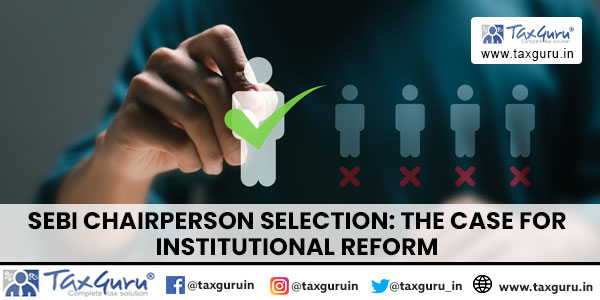
M. Damodaran
Chairperson, Excellence Enablers
Former Chairman, SEBI, UTI, IDBI
Summary: As Diwali brings hope and reflection, this article delves into a vital issue concerning SEBI’s leadership selection. Amid ongoing speculation over the current SEBI Chairperson’s tenure, the focus should shift from personal conjectures to the larger structural and procedural frameworks guiding such appointments. Key misconceptions—such as limiting Chairperson roles by private sector experience or gender—are unfounded and divert from essential discussions on SEBI’s functional autonomy. As an independent regulatory body, SEBI should not be perceived as a government subsidiary, underscoring the importance of an unbiased, knowledgeable selection committee. Historically, leaders like Dr. C. Rangarajan emphasized three vital qualifications: experience in finance, legal expertise, and prior leadership roles. Strengthening the process further, a Search-cum-Selection Committee is recommended over mere applications, ideally led by finance experts with an in-depth, conversational interview style. Moreover, introducing a twice-yearly reporting structure to Parliament could enhance accountability while preserving autonomy. Drawing from international practices, pre-selection consultations with parliamentary committees could reduce post-appointment criticism. Finally, time-sensitive and transparent procedures will help SEBI avoid potential gaps in leadership, sustaining its integrity and independence.
INSTITUTIONS, NOT INDIVIDUALS
The problem with processes that are in place, but are not
critically reviewed, is that improvements are never
considered. It is time to revisit the process for selection
and appointment of persons to regulatory positions.
Page Contents
- A Time for Reflection and Change
- Beyond Speculation: The Real Discussion Needed
- Dispelling Misconceptions: Private Sector Experience
- Breaking Gender Stereotypes in Regulatory Appointments
- SEBI’s Unique Status: More Than a Government Office
- Rethinking Selection Committee Leadership
- Essential Qualifications: The Rangarajan Framework
- Learning from International Best Practices
A Time for Reflection and Change
Diwali and the impending new year are harbingers of hope, and offer the opportunity to address the possibility of change, hopefully for the better. It is in this background that this newsletter looks at a major issue that has been occupying significant mind space.
Beyond Speculation: The Real Discussion Needed
For some weeks now, the media has been speculating on whether the present Chairperson of SEBI will stay till February, 2025 or leave before her term expires, or for that matter, be reappointed to serve another term. The answer to these questions is firmly rooted, in most cases, in the personal beliefs, biases or even ideological leanings of those that have chosen to express their views. The objective in addressing this here is not to dwell on the individual concerned, and the period for which she will continue to hold her present office. The procedural and substantive issues which should underlie the selection and appointment of the Chairperson of SEBI is what should merit our attention.
Dispelling Misconceptions: Private Sector Experience
Before getting to the larger issues, it is best to address those that have no basis whatsoever in fact or in law. The first of these is whether a person from the private sector should be appointed as Chairperson or Member of a regulatory organisation. There is nothing in law or regulations to prevent such an appointment. What is more, there have been instances in the past where persons from the private sector were identified as the right candidates and appointed to occupy regulatory positions.

Breaking Gender Stereotypes in Regulatory Appointments
An equally, if not more, irrelevant question, is whether such appointments ought to be a male preserve. In addition to recognising that such a provision, if enacted in law, would run counter to Constitutional provisions, it is appropriate to recall that many women of substance have held regulatory positions, and have distinguished themselves in the discharge of such responsibilities. Tangential issues, such as gender preferences, in regulatory appointments, should not detract from the real issues involved.
SEBI’s Unique Status: More Than a Government Office
Addressing the specific requirements of SEBI, it is useful to recognise that SEBI is neither an attached office nor a subordinate office of the Government of India. It is a creature of statute, and should not be equated to, or treated in similar fashion as, an organisation set up by an administrative instrument. For it to discharge its duties impartially and independently, it is necessary that it has the functional autonomy to do so, and equally importantly, is perceived as having the functional autonomy that should characterise its working.
Rethinking Selection Committee Leadership
For functional autonomy to become a fact it is necessary that the Government of India does not become the single authority to decide on the incumbent of this office. There was a practice in the past where the Selection Committee was headed by a distinguished individual with a very high standing in the financial sector. To strike a personal note, when the author of this piece was selected, the Selection Committee was headed by Dr. C. Rangarajan, a person whose standing and accomplishments do not require elaboration. In subsequent instances, the Selection Committee came to be headed by the Cabinet Secretary. There are two issues involved in having the Cabinet Secretary head the Selection Committee. The first problem is that the organisation could be perceived to be a subordinate office of the Government of India. Secondly, even though the position of Cabinet Secretary is the highest in the civil service, it is not reasonable to expect that the holder of that office would necessarily have a good understanding of the securities market, and therefore, of the kind of person required to be selected for that position. The present incumbent, with formal professional qualifications, and a lifetime of experience in the financial sector, is a glorious exception.
Essential Qualifications: The Rangarajan Framework
What should a Selection Committee be looking for when identifying a suitable candidate? The SEBI Act, which provides for the appointment of the Chairperson, is not helpful in this regard. Dr. Rangarajan, with whom I broached this subject, a few months after I had been appointed, mentioned that ideally the candidate selected should have at least the following 3 qualifications. Firstly, he/she should have been a part of the financial sector, even if that is not his/her main area of expertise. Secondly, the person concerned should have a qualification in law because understanding, writing and enforcing regulations will gain considerably if the head of the organisation has a clear understanding of the prescriptive arrangements that are being put in place, and how they are to be enforced. The third requirement, identified by him, is that the person selected should have headed at least one organisation in his/her career, prior to being appointed as Chairperson SEBI. It is entirely possible that another Selection Committee will come up with other necessary attributes required to be had by the selected candidate.
The nature of the Committee needs to be revisited. The present practice seems to be to invite applications from persons desirous of being considered for selection. While such an approach is not to be decried, it should not be the only manner in which possible candidates are sourced. It is necessary for the Committee to be a Search-cum-Selection Committee, so that in addition to considering the appropriateness of the applicants, the Committee could look for persons who fit the bill, but have not chosen to throw their hat in the ring. The credibility of the organisation will gain significantly, if a suitable person is persuaded to accept the position, rather than to compete for the position. The related procedural step of having a short interview with the candidates, with the interview being conducted by a Committee, all of whose members do not have domain familiarity, should be suitably modified to provide for in-depth conversation, including, but not limited to, ascertaining the vision the candidate has, with regard to the responsibility of heading the organisation.
There is also the question of accountability of the Chairperson, subsequent to appointment. Presently, the accountability would seem to lie to the Ministry of Finance, and in a sense, the Government of India. Considering that there are public sector entities that are also regulated by SEBI, the possibility of pressure being exerted by Government functionaries on SEBI cannot be ruled out. The ideal situation would be for the organisational head to report twice a year to the appropriate Committee of Parliament. Such an approach would strengthen the concept of functional autonomy, while ensuring that the organisation remains accountable.
Learning from International Best Practices
In countries like the USA, every person identified for appointment to an important office has to appear before a Committee of the House or the Senate, which would then assess the credentials of the person, as also look at the past track record or any other matter that might negatively impact the functioning of that person in the office to which he/she is proposed to be appointed. Such an approach might reduce, if not eliminate, the possibility of complaints of lack of credentials and suitability, subsequent to the person being appointed. Post appointment mud slinging is never the best way for the head of a regulatory organisation to get started on the assignment.
In the Indian context, the best procedure would be to have a Search-cum-Selection Committee, headed by a very distinguished person, preferably from the area of finance, with Committee members selected for their ability to contribute to the process, rather than being ex-officio members of the Committee. Having shortlisted the candidates, the Committee should invest adequate time in studying the past track record of each candidate, and in ascertaining whether the candidates have, in their minds, a roadmap for the organisation for the next few years. A candid conversation, rather than a question and answer session, would be the appropriate method to yield the right results. Once the Committee identifies a suitable candidate, he/she should be requested to appear before the Consultative Committee of the Ministry of Finance, so that members of that Committee can have a constructive pre-selection conversation with the concerned candidate. All reservations and doubts should be addressed during that conversation. It is only when the Consultative Committee clears the candidate, that the candidature should be put up to the Appointments Committee of the Cabinet for approval, and for issue of orders. Such a procedure would be a confidence building measure that will positively impact the credibility of the organisation.
News reports are abuzz with speculation on who is likely to be next Chair of SEBI. Names are being trotted out, based on track records in their present or previous positions. Considering that there is not too much time to complete the process of selection and appointment, presuming that there is no reappointment, it is imperative that a good robust process should be firmed up, and the selection in accordance with that process should be fast tracked. Absent that, we might witness the unfortunate spectacle of the present Chairperson’s term coming to an end, and no one being appointed, in time, as a successor. Such a possibility will lead to jockeying which an organisation of such importance can ill afford.
Tailpiece
Long years ago, an incumbent Chairperson was asked why he was not appearing for an interview for being considered for another term. His response was that “he was not a supplicant, not an applicant, a candidate or a job seeker”.




